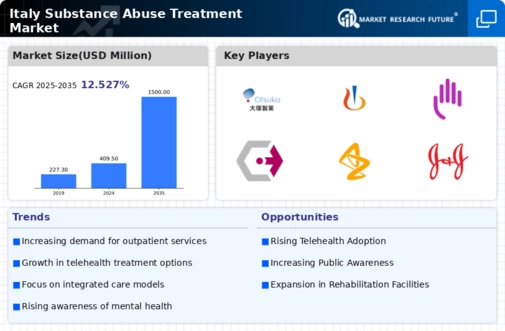Integration of Mental Health Services
The integration of mental health services into substance abuse treatment is emerging as a significant driver in the substance abuse-treatment market. In Italy, there is a growing recognition of the interplay between mental health and substance use disorders. Approximately 40% of individuals with substance use disorders also experience co-occurring mental health issues. This realization has prompted healthcare systems to adopt more comprehensive treatment models that address both aspects simultaneously. As a result, treatment facilities are increasingly offering integrated services, which may enhance patient outcomes and satisfaction. This shift not only reflects a more holistic approach to care but also indicates a potential expansion of the substance abuse-treatment market as more individuals seek help for interconnected issues.
Policy Changes and Regulatory Support
Recent policy changes and regulatory support in Italy are emerging as vital drivers for the substance abuse-treatment market. The government has implemented various initiatives aimed at improving access to treatment and support services for individuals struggling with addiction. For example, funding for rehabilitation programs has increased, allowing for the expansion of treatment facilities and services. Additionally, new regulations are being introduced to ensure that treatment options are evidence-based and effective. These supportive measures not only enhance the quality of care but also encourage investment in the substance abuse-treatment market, fostering an environment conducive to growth and innovation.
Advancements in Treatment Technologies
Technological advancements are playing a pivotal role in shaping the substance abuse-treatment market. Innovations such as digital therapeutics, mobile health applications, and teletherapy platforms are becoming more prevalent in Italy. These technologies facilitate access to treatment, allowing individuals to receive support from the comfort of their homes. For instance, the use of mobile applications for monitoring recovery progress has shown promising results in improving adherence to treatment plans. Furthermore, the integration of artificial intelligence in treatment protocols may enhance personalized care, tailoring interventions to individual needs. As these technologies continue to evolve, they are likely to attract a broader audience to the substance abuse-treatment market, potentially increasing its overall size and scope.
Increased Public Awareness and Education
Public awareness campaigns and educational initiatives regarding substance abuse are significantly influencing the substance abuse-treatment market. In Italy, efforts to destigmatize addiction and promote understanding of its complexities have gained momentum. Educational programs in schools and communities aim to inform individuals about the risks associated with substance use and the importance of seeking help. This increased awareness is likely to lead to more individuals recognizing their need for treatment, thereby driving demand within the market. Moreover, as society becomes more informed about the available resources and treatment options, the substance abuse-treatment market may experience growth as more people actively seek assistance.
Rising Prevalence of Substance Use Disorders
The increasing prevalence of substance use disorders in Italy is a critical driver for the substance abuse-treatment market. Recent data indicates that approximately 3.5% of the Italian population struggles with addiction issues, leading to a heightened demand for treatment services. This trend is particularly evident among younger demographics, where substance experimentation is more common. As awareness of addiction's impact on public health grows, the need for effective treatment options becomes more pronounced. Consequently, healthcare providers are expanding their services to address this rising demand, which is likely to stimulate market growth. The substance abuse-treatment market is thus positioned to evolve, adapting to the needs of a population increasingly affected by addiction.


























Leave a Comment